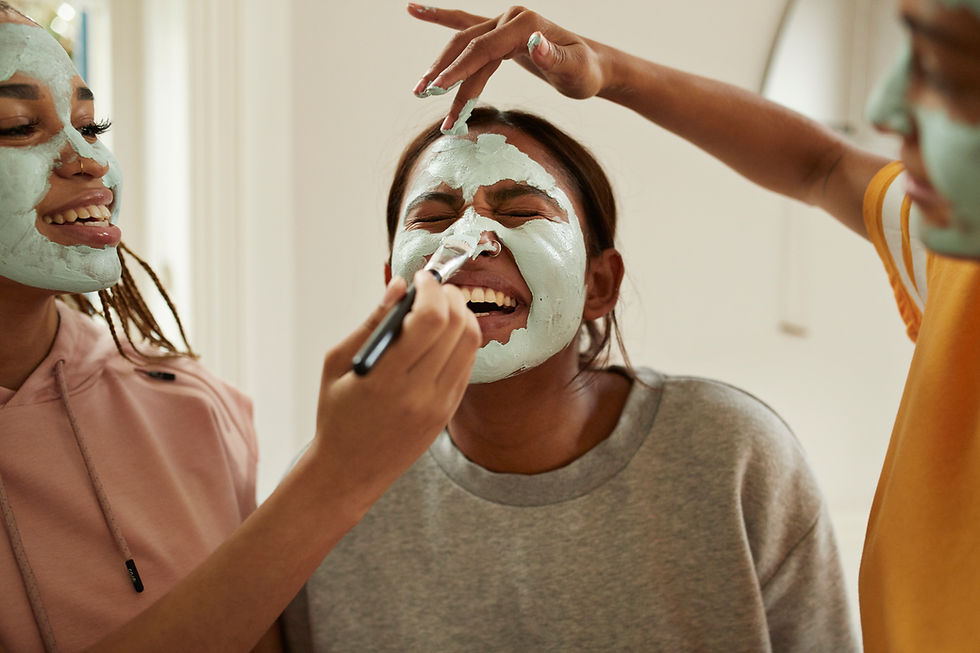How to Identify your Skin Type
- saltsiskincare
- Oct 4, 2023
- 4 min read

If you haven't already, head over and read our article all about skin, and what it actually is here!
Okay, now that we've covered the basics, it's time to identify your unique skin type. Take a few moments to yourself, as this will involve a little self-reflection.
You could even grab a pen and paper and jot down your answers to the following questions for a more intuitive, self-guided identification, or you can use the interactive poll we created below.
We recommend conducting this identification after a skin detox, as many of your current skin care products may be masking your skin type and disrupting your natural skin barrier. It can take up to three months to reveal your true skin type during a skin detox, then a further three months is often required to repair your natural skin barrier if you have dry, oily, combination, acne-prone, sensitive, or prematurely ageing skin. However, for the sake of conducting this quiz, you may be able to draw on previous experiences of going skincare-free, or you may even withhold from using your current skincare products for a day or two.
Now you are ready, look in a mirror bare-faced, without judgement, and full of love for your unique features. Do you notice that your skin is shiny? This is common for people with an Oily Skin Type. Or, is it flaky and scaly, with a tight feeling? This is common for people with a Dry Skin Type. Is it flaky and scaly in some areas, but shiny between your eyebrows and across your nose and forehead (this is known as the T-Zone)? This is common for people with a Combination Skin Type. Is it hydrated and comfortable, and there is no shine? This is what is known as a Normal Skin Type.
What is Your Unique Skin Type?
Oily Skin ~ e.g. shiny, large pores
Dry Skin ~ e.g. flaky, scaly, rough, tight, itchy
Combination Skin ~ e.g. oily nose and forehead, dry cheeks
Normal Skin ~ e.g. comfortable, even texture, no shine
This is your underlying skin type, which varies widely depending on many factors including your unique ethnicity, genetic make-up, age, hormonal balance, and lifestyle, among others. Many factors can adjust your unique skin type, and your skin type can change completely over time, as you do. Things like stress, hormones, humidity, climate, and the natural process of ageing are just a few of these factors. As we mentioned, several skincare products can actually mask your underlying skin type, adding to your confusion and leaving many consumers, like you, unaware of what their skin actually needs.

If you're still a little unsure here is your complete guide to identifying your skin type; and, of course, our recommended remedies, and skincare routines, based on your unique skin needs. Oily Skin. Identifying Factors:
Oil on the surface of the skin.
Visible oil on tissue after blotting on face.
Large pores, few wrinkles, and thick skin.
Acne blemishes, blackheads, and whiteheads are common.
Remedies:
Moisture! Although this may seem counterintuitive, your skin may be producing excess oil to counterbalance a lack of proteins, lipids, and skin hydration.
It is best not to try to 'strip' away excess oil.
Ditch the harsh foaming cleansers full of oil-stripping surfactants - this will only trick your body into producing more oil.
Try gentle products and ditch exfoliation until you have repaired your skin barrier - scrubbing away your exterior skin cells can cause acne to spread deeper into the layers of your skin.
Your new besties are lightweight, balancing, and non-comodogenic products!
Ideal Skincare Routine:
AM: SPF, light-weight, non-comodogenic make-up.
PM: Balancing clay cleanser, and soothing face oil to replenish skin lipids while you sleep!
Dry Skin.
Identifying Factors:
No oil on the surface of the skin.
Little oil visible on a tissue after blotting on face.
It can appear dull, rough, flaky, or scaly.
Feels tight when smiling.
May appear drawn in, giving a 'sunken' appearance when dehydrated.
Thinner skin tissue with visible redness and veins.
Prone to fine lines, itchiness, and sensitivity.
Remedies:
Gentle, soothing, and hydrating ingredients.
Applying a top lipid barrier to lock in moisture and strengthen the skin's natural protective barrier.
Avoid hot water when showering or cleansing your face.
Apply a face oil morning and night.
Ideal Skincare Routine:
AM: Face oil, SPF, light-weight, non-comodogenic make-up.
PM: Rejuvenating cleansing melt or oil to remove dirt, SPF, and make-up, and a soothing face oil to replenish skin lipids while you sleep.
Combination Skin.
Identifying Factors:
T-Zone (forehead and nose) is oily.
Cheeks are dry, or normal.
Seasonal changes, e.g. very dry in winter, and very oily in summer.
Often, hormonal imbalances and fluctuations will present as combination skin.
Remedies:
Utilising skincare products in line with the presentation of your combination skin, e.g. adopting a dry skin routine during winter months and changing it up for an oily skin approach when summer arrives, or you might use a face oil on your cheeks and around your eyes and a clay cleanser just across your T-Zone.
Regular cleansing is key. Use a clay cleanser in the AM to balance your skin. Then use a rejuvenating oil based cleanser at night to remove dirt, sunscreen, and make-up.
You could even try double cleansing at night. Double cleansing involves the use of an oil based cleanser, followed by a water based cleanser so your skin is getting the benefits of both while you sleep, which is particularly useful if you have combination skin.
Ideal Skincare Routine:
AM: Clay cleanser, SPF, light-weight, non-comodogenic make-up.
PM: Rejuvenating cleansing melt, clay cleanser, followed by a soothing face oil.
If you don't feel represented by the information provided here you may like to check out our article on Secondary Skin Concerns, for those who may suffer from acne-prone, sensitive, dehydrated, or prematurely-ageing skin.





Comments